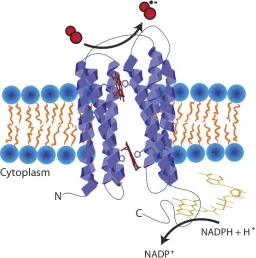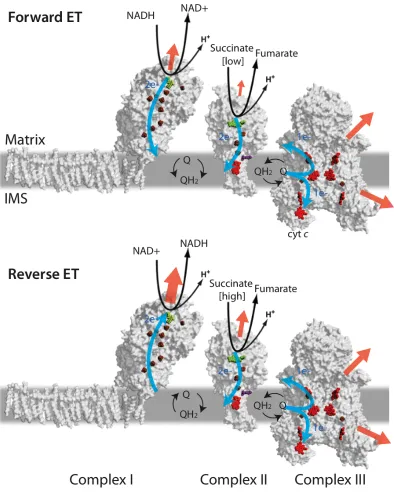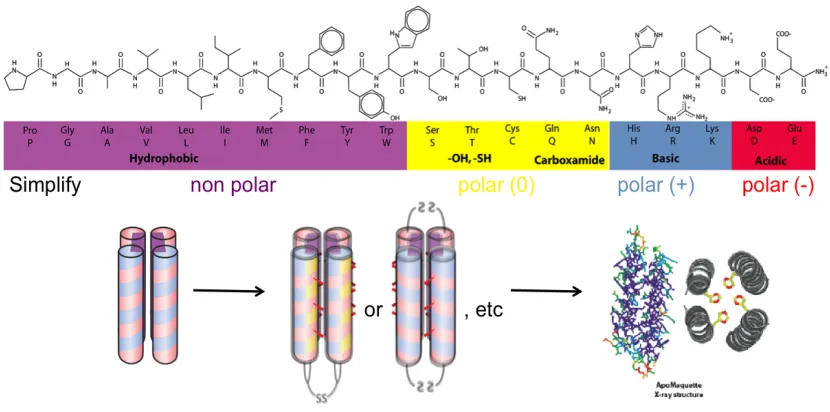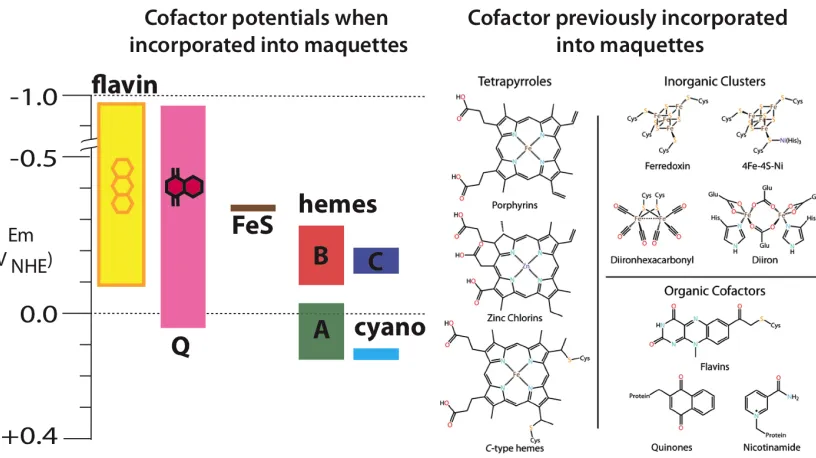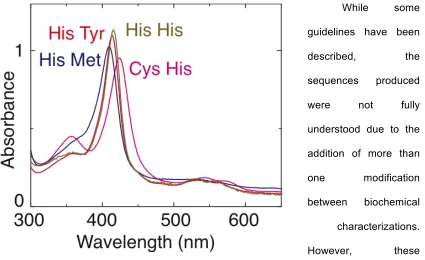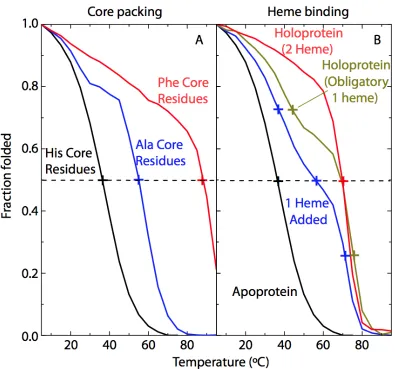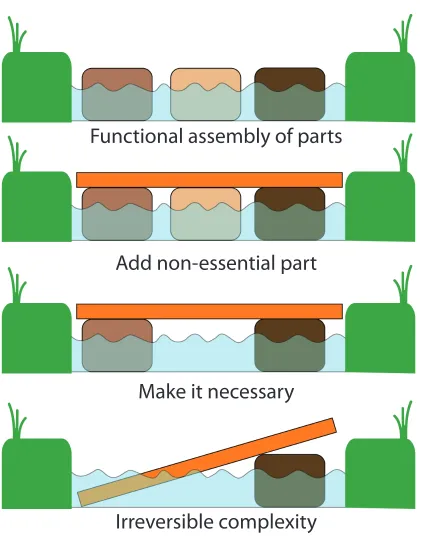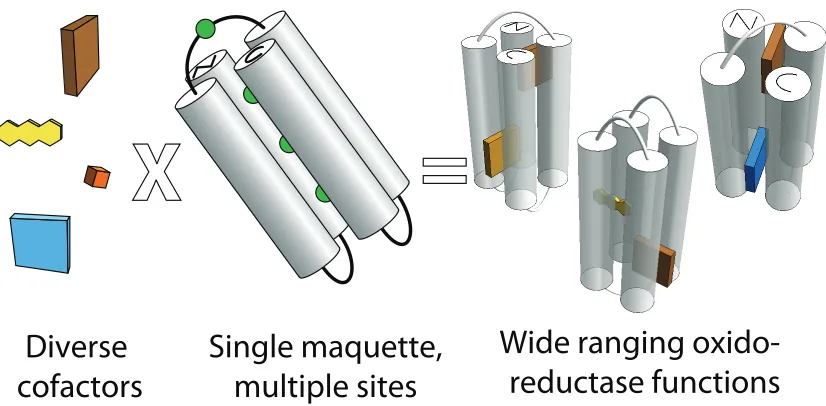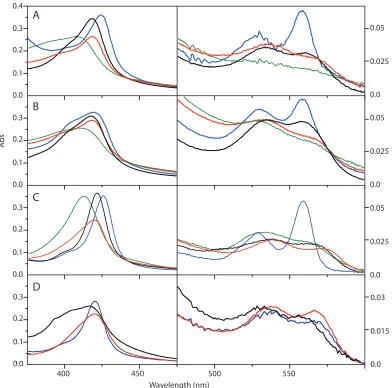University of Pennsylvania
ScholarlyCommons
Publicly Accessible Penn Dissertations
1-1-2014
Engineering Oxygen Reactivity in Heme-Protein
Maquettes
Molly Marie Sheehan
University of Pennsylvania, sheehan.molly@gmail.com
Follow this and additional works at:
http://repository.upenn.edu/edissertations
Part of the
Biochemistry Commons, and the
Biophysics Commons
This paper is posted at ScholarlyCommons.http://repository.upenn.edu/edissertations/1438 For more information, please contactlibraryrepository@pobox.upenn.edu.
Recommended Citation
Sheehan, Molly Marie, "Engineering Oxygen Reactivity in Heme-Protein Maquettes" (2014).Publicly Accessible Penn Dissertations. 1438.
Engineering Oxygen Reactivity in Heme-Protein Maquettes
Abstract
Fundamental questions of protein cofactor oxygen reactivity are left unanswered even after years of research due to the limitations imposed by the complexity of natural systems. Natural electron transport proteins are often large with many spectrally overlapping cofactors and fragile to mutation due to multiple roles of each amino acid. The study of the products oxygen reduction is further made difficult by inadequate available methods for kinetic resolution with quantitative yields of different reactive oxygen species (ROS). To first examine how proteins can avoid oxygen reduction for oxygen transport, as in natural globins, an oxygen transporter is designed from first principles of protein folding with each intermediate characterized. This is the first example of a transparently-crafted protein design functioning at natural rates. The ease of this design process, only three steps, and the minimalism of the design, only 8 different amino acids, calls into question many assumptions of what is necessary for a functional protein. This work suggests that functional success is easier reached by modification of gross properties of proteins rather than attempting structural exactness. This work may also aid future designs without necessitating a return to first principles because it not only produces a functional design but a toolbox from which to engineer.
Oxygen reactivity was further studied through the development of a system for differentiating the rates and yields of superoxide, hydrogen peroxide and hydroxyl radicals. A series of man-made proteins were tested for oxygen binding, each aforementioned ROS production, and ligand exchange rates to uncover differences in ROS species production and mechanisms. It was found that it takes a single repetitive mutation to design from stable oxygen binder to a rapid outer-sphere superoxide generator. Further, another small set of changes confer preferential hydrogen peroxide generation without a superoxide intermediate through an inner-sphere mechanism. The ability to elucidate mechanistic details of highly homologous proteins and resolve each species of ROS allows us to learn about protein oxygen chemistry and apply this knowledge to the interpretation of data from natural systems, as well as use this knowledge to engineer forward towards industrially- and medically-applicable designer proteins.
Degree Type Dissertation
Degree Name
Doctor of Philosophy (PhD)
Graduate Group
Biochemistry & Molecular Biophysics
First Advisor P. Leslie Dutton
Keywords
design, globin, minimal, oxygen, protein, ROS
Subject Categories Biochemistry | Biophysics
ENGINEERING OXYGEN REACTIVITY IN HEME-PROTEIN MAQUETTES © 2014
iii
!
DEDICATION
iv
!
ACKNOWLEDGEMENTS
Many people have contributed to my reaching not only this point, but making it an enjoyable process that I will always look back upon fondly.
First and foremost, I would like to thank my P.I., Les Dutton, for everything he has done for me over the years. Les has supported my independent growth from day one, somehow building my confidence while challenging my ideas simultaneously. He has recruited a phenomenal lab full of diverse, creative people that I look forward to working with every day. Les has been a great role model in balancing a rich personal life in addition to fulfilling scientific career. His trust in us and our ideas allows us to grow up into creative scientists unafraid of a heretical scientific thought.
Christopher Moser has also been an invaluable asset in my life in the Dutton lab. Chris is an experimental powerhouse and I cannot recall ever asking him how to do an experiment without him finding a clever thorough solution to perform it shortly. Chris has also helped me learn about each equipment setup he has kindly built. Each scientific ‘problem’ I have come across over the years that I could not overcome myself, Chris has not only helped me through but also done so while bestowing onto me as much knowledge as possible in the most light-hearted way possible. While I think it is likely only possible that I absorbed a mere percentage of what Chris knows over these years, I will treasure it in my future scientific endeavors.
v
!
offering his laboratory and students to my projects, particularly the help of Paul Straus in collecting the FTIR data in this thesis.
I would also like to thank my undergraduate advisor, Robert Fairman, of Haverford College for getting me started. He initially peaked my interest in protein design and made biochemical research accessible to a mere biology major.
My labmates have also been a source of entertainment and scientific debate. In particular, aside from their friendship which I also value, Lee Solomon, Tammer Farid, Sarah Chobot Hoakanson, Bryan Fry, Bohdana Discher and Goutham Kodali have always been available throughout my stay in the Dutton lab to discuss data, debate theories and generally also make day-to-day life more pleasant. Sarah was also my mentor when I first joined and instilled upon me much wisdom at how to survive in a lab full of fairly messy men. Her insight has no doubt saved me countless hours chasing down cuvettes or data resulting from contaminants. Bryan Fry has also been incredibly helpful in troubleshooting equipment issues. Even when we cannot fix the Olis, as we often cannot, he helps me not explode in frustration as my samples oxidize.
vi
!
ABSTRACT
ENGINEERING OXYGEN REACTIVITY IN HEME-PROTEIN MAQUETTES Molly M. Sheehan
P. Leslie Dutton
Fundamental questions of protein cofactor oxygen reactivity are left unanswered even after years of research due to the limitations imposed by the complexity of natural systems. Natural electron transport proteins are often large with many spectrally overlapping cofactors and fragile to mutation due to multiple roles of each amino acid. The study of the products oxygen reduction is further made difficult by inadequate available methods for kinetic resolution with quantitative yields of different reactive oxygen species (ROS). To first examine how proteins can avoid oxygen reduction for oxygen transport, as in natural globins, an oxygen transporter is designed from first principles of protein folding with each intermediate characterized. This is the first example of a transparently-crafted protein design functioning at natural rates. The ease of this design process, only three steps, and the minimalism of the design, only 8 different amino acids, calls into question many assumptions of what is necessary for a functional protein. This work suggests that functional success is easier reached by modification of gross properties of proteins rather than attempting structural exactness. This work may also aid future designs without necessitating a return to first principles because it not only produces a functional design but a toolbox from which to engineer.
vii
!
viii
!
TABLE OF CONTENTS
Dedication...iii
Acknowledgements...iv
Abstract...vi
List of Topics...viii
List of Tables...xii
List of Figures...xiii
Chapter 1: Introduction...1
1.1 Oxygen in metabolism...1
1.1.1 The oxidoreductase family...1
1.1.2 Heme proteins as oxidoreductases...3
1.1.3 Globins...4
1.2 Reactive oxygen species...8
1.2.1 What is ROS? ...8
1.2.2 Purposeful ROS production proteins...9
1.2.3 Mitochondrial ROS production and disease...10
1.2.4 Theories of mitochondrial ROS production...12
1.3 Challenges in ROS detection and control...16
1.3.1 Probe delivery and quantitation...16
1.3.2 Controlling oxygen reactivity for protein material engineering...17
1.4 Goals of This Thesis...19
1.5 References...21
Chapter 2: The Maquette Approach...26
2.1 The diverse field of protein design...26
2.2 Maquette design...29
2.2.1 The approach...29
2.2.1 The accomplishments...31
2.3 Applications of maquettes...35
2.3.1 Maquettes in protein engineering...35
2.3.2 Maquettes as a model system...39
2.4 What is next for maquette design...40
2.5 References...40
ix
!
3.1 Introduction...43
3.1.1 Virtues of minimal design...43
3.1.2 Former oxygen transporter designs...46
3.1.3 Limited amino acid libraries...47
3.2 Designing functional requirements independently...47
3.2.1 Design of a stable water-soluble !-helical protein...50
3.2.2 Design of hexacoordinated bis-histidine heme ligation that promotes rapid histidine to O2 exchange...52
3.2.3 Design of high affinity heme binding in the interior of the !-helices……..…54
3.2.4 Design of water-restricted heme site and development of an equilibrium affinity favoring O2-binding at prevailing aqueous O2 concentrations...56
3.2 Conclusions about natural systems: Lower limits of amino acid diversity for a functional protein...58
3.3 Conclusions about engineering: A new paradigm for protein design………….59
3.3.1 Orderly reconstruction from first principles by testing intermediate designs...59
3.3.2 Engineering through modification of gross properties...61
3.4 References...62
Chapter 4: Designing Hyperstable Oxidoreductases...66
4.1 Introduction...66
4.1.1 Stability and its role in protein design and engineering………..66
4.1.2 Thermophiles………..………..………..………..67
4.1.3 The search for blood substitutes………..………..………68
4.2 Rebuilding a functional protein without assumptions confers stability……….68
4.2.1 Design………..………..………..………..………69
4.2.2 Stability measures………..………..………..……….71
4.2.3 Gas-binding measures………..………..………..………..72
4.2.4 Ligand Exchange Dynamics………..………..………...75
4.2.5 Structure by NMR………..………..………..………..78
4.3 Conclusions………..………..………..………..………..……..80
4.3.1 Simplicity confers stability, not diminishes it………....80
4.3.2 Sliding rocks………..………..………..………..………….82
4.3.3 Suggestions for computation and directed evolution………..83
4.3.4 Potential as a platform for blood substitutes and other applications………84
4.4 References………..………..………..………..………..……….86
Chapter 5: Development of a ROS Laboratory……….…..……..………90
5.1 Introduction………..………..………..………..………...……..……90
5.1.1 Maquettes as model systems………..………..………..…..90
5.1.2 ROS kinetic resolution………..………..………..………..93
x
!
5.2.1 Design and predictions………..………..………..………..…...96
5.2.2 Oxygen binding………..………..………..………....101
5.2.3 Superoxide production………..………..………..………102
5.2.4 Hydrogen peroxide production………..………..……….104
5.2.5 Hydroxyl radical production………..………..………..106
5.2.6 Histidine and gas binding dynamics………..………..………109
5.3 Resolving ROS………..………..………..………..……….111
5.3.1 Resolvable species of ROS produced………..………..…………111
5.3.2 Resolvable mechanisms of ROS production………..………...113
5.4 Conclusions.………..………..………..………..……….116
5.5.1 Learning about natural systems………..………..………..116
5.5.2 Engineering more robust protein systems………..………118
5.5 References………..………..………..………..……….119
Chapter 6: Conclusions………..……….………..………...……122
6.1 New rules of protein design………..………..………..………....122
6.2 New applications for protein design………..………..………..…….126
6.2 Future directions………..………..………..………..……….128
6.3 References………..………..………..………..………..……..129
Appendix 1: Materials and Methods………..….…..……….………131
A1.1 Protein expression and purification ………..………..………….……..131
A1.2 Peptide Synthesis………..………..………..………..………....131
A1.3 Heme titrations………..………..………..………..………..132
A1.4 Redox titrations ………..………..………..………..………132
A1.5 Low-temperature UV-Visible Spectroscopy………..………..………...133
A1.6 Stopped-flow UV-Visible Spectroscopy………..………....134
A1.7 Circular Dichroism (CD)………..………..………..………134
A1.8 Heme Retention………..………..………..………..……….134
A1.9 Nuclear Magnetic Resonance (NMR) Spectroscopy………..………..134
A1.10 CO Flash Photolysis………..………..………..………..……..135
A1.11 Fourier Transform Infrared (FTIR) Spectroscopy………..……….136
A1.12 Superoxide Detection………..………..………..………..137
A1.13 Hydrogen Peroxide Detection………..………..………..………...137
A1.14 Hydroxyl Radical Detection………..………..………..………138
xi
!
Appendix 2: Supplemental Data………..………..……...……..140
A2.1 Gas binding………..………..………..………..……….…...140
A2.2 Reactive oxygen species detection………..………..……….143
A2.3 CO flash photolysis………..………..………..………145
xii
!
LIST OF TABLES
Chapter 3
Table 3.1: Heme-binding protein characterization……….53
Chapter 4
Table 4.1: Ligand exchange dynamics and energies of activation………..76
Chapter 5
xiii
!
LIST OF FIGURES
Chapter 1
Figure 1.1: ROS potentials and reactions……….….2
Figure 1.2: Most common naturally occurring hemes………..………4
Figure 1.3: Pentacoordinate and hexacoordinate heme binding………6
Figure 1.4: Heme coordination shown for pentacoordinate binders………..7
Figure 1.5: NADPH oxidase (Nox) cartoon structure………..……….9
Figure 1.6: The first three complexes of the mitochondrial ET chain………..14
Chapter 2 Figure 2.1: Maquette design………..29
Figure 2.2: Cofactors and potentials……….………32
Figure 2.3: Heme b ligations to a single maquette by UV-visible spectroscopy………...33
Figure 2.4: Thermal melts of a series of single chain heme b maquettes………..34
Figure 2.5: Illustration of Muller’s Ratchet………...36
Figure 2.6: Maquette approach to functional designs………37
Figure 2.7: Oxygen binding shown functional domain independence……….38
Chapter 3 Figure 3.1: Complexity of natural and man-made proteins………...45
Figure 3.2: Heme and oxygen binding to maquettes……….47
Figure 3.3: Design of a minimal oxygen-binding protein from first principles………49
Figure 3.4: Heme titrations of 5, 4, 3, 2, and 5A9EA79E………..51
Figure 3.5: Redox titrations of 3, 4, and 5………53
Figure 3.6: UV-visible spectra at -15°C………55
Figure 3.7: UV-visible kinetics of 4 and 5 by stopped-flow mixing………..56
Chapter 4 Figure 4.1: Depiction of synthetic protein residues………70
Figure 4.2: Thermal stability………..71
Figure 4.3: Stability over time………72
Figure 4.4: UV-visible spectra at -15°C………73
Figure 4.5: FTIR of the thermostable protein in comparison to previous maquettes……74
Figure 4.6: Oxygen-binding kinetics upon rapid mixing……….75
Figure 4.7: CO flash photolysis at 20%, 50% and 100% CO………...77
Figure 4.8: Changes in structure upon heme binding………79
Chapter 5 Figure 5.1: Topologies of maquettes for ROS study………..92
Figure 5.2: SO production scheme from one-heme maquettes………...98
Figure 5.3: ROS production possibilities from two-heme maquettes………..99
Figure 5.4: Oxygen-binding properties of maquettes………..102
Figure 5.5: SO production as detected by MCLA……….104
Figure 5.6: Hydrogen peroxide production as detected by Amplex Red and HRP…….105
Figure 5.7: Hydroxyl radical production as detected by AO7……….108
xiv
!
Appendix 2: Supplemental Data
Figure A2.1: CO binding data of C.1 and 5………...140
Figure A2.2: Oxygen binding to C………..141
Figure A2.3: Oxygen binding to C.1……….………..142
Figure A2.4: Spectra for stopped-flow peroxide detection………..143
Figure A2.5: Spectra for stopped-flow hydroxyl radical detection……….………144
Figure A2.6: CO photolysis of A……….………145
Figure A2.7: CO photolysis of B……….…………146
Figure A2.8: CO photolysis of B.1………..…………147
Figure A2.9: CO photolysis of C……….………148
Figure A2.10: CO photolysis of C.1………149
1
Chapter 1: Introduction
1.1 Oxygen in metabolism
1.1.1 The oxidoreductase family
Since free dioxygen became available in the Earth’s atmosphere 2.3 billion years ago, oxygen metabolism is central to the survival of aerobic life (Falkowski 2006). Prior to the first photosynthetic events producing oxygen from water, the atmosphere was highly reducing owing to the relatively poor oxidizing ability of the prior oxidant, nitrogen. Today, oxidoreductases make up over 25% of all known proteins (Dutton & Moser 2011).
Dioxygen’s powerful oxidation ability leads to reactions incorporating it into organic molecules as well as reduction and oxidation of both itself and other molecules. These reactions’ thermodynamic favorability is governed by its reactivity and ubiquitous existence throughout cells. Despite being a simple molecule, its chemistry is complex and diverse. If not properly controlled and contained, dioxygen’s oxidizing ability will lead to unfavorable side reactions oxidizing proteins, lipids and other biological molecules through the production of reactive oxygen species (ROS) (Figure 1.1B). In order to both harness and control dioxygen chemistry, a wide range of proteins has evolved to catalyze reactions from superoxide dismutation and peroxidation to respiratory and photosynthetic energy production. Because oxygen is so vital to respiratory life’s existence, additional sets of proteins, globins, have evolved to bind, transport, store and deliver dioxygen in larger organisms (Wajcman et al. 2009).
2
more complex natural reactions as an oxygen donor for the addition of oxygen groups on organic molecules. Even though many of these reactions are thermodynamically favorable, most will not occur without a catalyst present in biological or room temperature conditions. These reactions do not occur because oxygen exists in its ground state in the triplet state and most products formed with organic molecules exist in the singlet state. Because a quantum-mechanically-forbidden spin flip must occur for the reaction to take place, these reactions will not occur with appreciable yields during collisional encounters. However, enzymes are able to use alternate paths to these reactions by either producing organic radicals that can freely react with triplet oxygen (Cantarella et al. 2003) or binding oxygen to paramagnetic metal ions to promote multi-electron processes, as in the case of monooxygenases like cytochrome P450 (Shaik et al. 2007). Unless these reactions are carefully controlled through fine enzymatic tuning, ROS will be released, leading to the damage discussed in section 1.2.
Figure 1.1: ROS potentials and reactions. (A) The four consecutive step reduction of oxygen to water through superoxide, hydrogen peroxide and hydroxyl radical intermediates is shown with reduction potential of each step vs. normal hydrogen electrode (NHE) at pH 7, 25°C with standard state of unit activity (Bertini 2007). Oxygen atoms depicted as red circles and hydrogen atoms as grey circles with proton additions not shown. (B) The reactions dioxygen can undergo without catalysis are shown towards the formation of ROS through either one or two electron processes, as well as dismutation of two oxygens to hydrogen peroxide and additional reduction of hydroxyl radical.
Damage
Cell Signaling
e-+
e-+
e-+
e-+
e--0.16 V
+0.89 V
+0.38 V
+2.31 V
3 1.1.2 Hemes in oxidoreductases
Oxidoreductases naturally contain a large variety of cofactors, or species that can partake in oxidation and reduction reactions, for their catalysis and electron transfer events. The most prevalent of these cofactors are flavins, quinones, iron-sulfur clusters and hemes, which are all essential for the mitochondrial electron transport chain. Flavins and quinones are capable of one- or two-electron transfer events. Iron-sulfur clusters can transfer as many electrons as they have irons but typically are involved in single electron transfers. Hemes, iron-centered porphyrin macrocycles, however are obligate one-electron transfer cofactors that can access a large range of reduction potentials through a variety of macrocycle substitutions. Hemes can be either covalently, as in c-type cytochromes, or non-covalently attached to proteins, as in a- and b-type cytochromes (Figure 1.2). They are present in a variety of oxidoreductases, as they can be efficient oxygen-binders and reducers, as well as promote high rates of electron transfer due to low reorganization energies allowed by their conjugated macrocycle ligand delocalizing electrons and ability to span a large range of reduction potentials (Bertini 2007).
4
Figure 1.2: Most common naturally occurring hemes.
1.1.3 Globins
Containing hexacoordinate and pentacoordinate hemes, the globin family of proteins today consists of a large variety of structurally similar proteins that perform a multitude of tasks. Globins are classically considered reversible oxygen-binders for the purpose of oxygen transport, but have more recently been found to perform electron transfer, NO scavenging and cytoprotection against ROS damage (Wajcman et al. 2009). Globins exist in Archea (Freitas et al. 2004; Moens et al. 1996), plants (Hoy et al. 2007) and vertebrates. Throughout these kingdoms they are active as monomers, dimers and tetramers, though each monomer consists of the globin fold. Discovered over 50 years ago, the globin fold consists of 8 !-helices surrounding a heme b group in a 3/3 canonical formation (Kendrew et al. 1958).
Typically oxygen-binding globins are thought to be pentacoordinate heme binders, with a free axial orbital open for gaseous ligand binding as in the cases of myoglobin and hemoglobin. However, it has been found that these oxygen binders
Heme
b
FeN OH OH O O N N NHeme
c
FeN Me Me OH OH O O N N N S-Protein S-Protein5
evolved from hexacoordinate heme binders, which may have evolved the ability to bind oxygen prior to stable pentacoordinate heme binding (Hoy et al. 2007). Likely owing to their predecessors, pentacoordinate heme binders still have a second histidine at a distal site, which acts to stabilize bound dioxygen in the oxyferrous state (Figure 1.3). The placement of this histidine in such close proximity to a pentacoordinate heme without it binding requires extreme stabilization and rigidity to the heme-binding site. This required structural tuning presents an evolutionary challenge, likely taking considerable iterations. These iterations would involve evolving through hexacoordinate oxygen-binding intermediates for which one histidine ligation was weakened but not fully removed from the iron coordination sphere.
6
Figure 1.3: Pentacoordinate and hexacoordinate heme binding. The left shows a pentacoordinate heme b (red) ligation to a single histidine (green) with distal, un-bound histidine as present in myoglobin. The right shows a hexacoordinate bis-histidine heme b ligation between two bis-histidines as present in neuroglobin.
The ideal KD for oxygen binding is organism-specific depending on the oxygen concentration its environment, such that globins become oxygen-saturated in highly oxygenated tissues and release their oxygen in those tissues requiring oxygenation. No matter the environment, however, the natural KD for oxygen to a pentacoordinate heme is not low enough to allow for efficient oxygen binding. In order to improve the stability of the oxyferrous state, pentacoordinate heme binders have conserved the distal histidine at such a distance from the open axial heme site that it can hydrogen bond to dioxygen
Myoglobin
Neuroglobin
Pentacoordination
Hexacoordination
!"#$%&' ()*
+) +
!"#$%&' ()*
+) + !"#$%&'
()* +)
+ !"#$%&'
()
* +
7
when bound (Perutz 1970). Additionally, when oxygen binds to the ferrous iron, an energetically favorable event of the iron fitting into the center of the porphyrin ring occurs due to the iron shrinking in size as it goes from high spin to low spin (Collman 1977). Once the oxygen settles into the porphyrin ring, the distal histidine is positioned such that it can accomplish the dual task of stabilizing the binding of dioxygen and sterically inhibiting the binding of more-linear carbon monoxide that would otherwise bind 200-fold better, posing a problem to oxygen transport even under the low normal physiological levels of CO (Perutz 1990) (Figure 1.4).
Figure 1.4: Heme coordination shown for pentacoordinate binders. From left to right: high-spin iron out of plane of the porphyrin ring in the ferrous state, low-spin oxyferrous state with ferrous heme bound to dioxygen and also NH group of distal histidine hydrogen bonded to oxygen, low-spin ferrous heme bound to carbon monoxide with sterically-impeding distal histidine.
8
oxygen transport proteins and are highly conserved (Burmester et al. 2004). Both neuroglobin and cytoglobin are capable of binding oxygen, though for much shorter periods of time than typical oxygen-transport globins (Dewilde et al. 2001). While it has been postulated that neuroglobin, in particular, may be responsible to tissue-level oxygen delivery to mitochondria, its up-regulation in hypoxic conditions and biochemical traits point to its more prominent role being an electron transport protein used to scavenge ROS (Fago et al. 2004; Kiger et al. 2011). Cytoglobin, which is also up-regulated in hypoxic conditions, may play a role in providing oxygen to dioxygen-mediated enzymes such as hydroxylases in addition to ROS mediation (Fago et al. 2004; Sugimoto et al. 2004). Even though the specific biological role of these globins has yet to be identified and more of their kind are still being identified (Kiger et al. 2011), their strong conservation across species suggests a primary role in mediating oxidative damage caused by ROS in tissues that are difficult to repair and/or are prone to hypoxic injury or increased ROS production.
1.2 Reactive oxygen species
1.2.1 What is ROS?
9
(Ferrari et al. 2004). Superoxide (SO) is the primary ROS which leads to most damaging oxidative effects due to its reaction cascade into hydroxyl and nitrogen radicals, whereas hydrogen peroxide is a well-known signaling molecule and will not, on its own, lead to the produciton of damaging radicals (Bell et al. 2007; Murphy 2009; Guzy & Schumacker 2006; Adler et al. 1999) (Figure 1.1). Despite the medical relevance of mitochondrial ROS production, the source of SO production in mitochondrial electron transport (ET) is still highly debated.
1.2.2 Purposeful ROS production proteins
Not all ROS production is bad though. Some proteins intentionally produce ROS. The most efficient natural ROS generators are NADPH oxidases (Nox). Nox enzymes are present throughout eukaryotes and are critical in processes including hormone synthesis, signal
transduction and
propagation, and killing pathogens (Sumimoto 2008; Brown & Griendling 2009). Despite their varied purposes, many of which have yet to be defined, they share a similar structure of an extra-membrane FAD for the oxidation of NADPH and Figure 1.5: NADPH oxidase (Nox) cartoon structure
10
7 transmembrane !-helices with bis-histidine binding of two heme bs 14Å apart to transfer electrons across the membrane for the production of SO, with one exception (Figure 1.5). Nox proteins are capable of producing large volumes of SO across membranes and are capable of generating enough ROS to kill microbes in the phagosomes of neutrophils (Babior et al. 1973; Segal 2004).
The only Nox not to produce superoxide is Nox4, a constitutive hydrogen peroxide producer. Despite high structural homology to other Nox enzymes (Martyn et al. 2006), the few structural differences found have lead to speculation as to how this enzyme preferentially produces peroxide, doubly reduced oxygen, from a one-electron transfer cofactor, heme b. The top theories implicate differences in extra-membrane loop regions, particularly the E loop, which may keep one superoxide near the heme site in close enough proximity to favor dismutation upon a second superoxide’s generation (Takac et al. 2011). More specifically, it is possible that changes in this loop region may allow for stable oxygen-binding to oxygen-reducing heme, with kinetics that would favor that heme receiving a second electron while in the oxyferrous state, allowing for two electrons to transfer to oxygen concertedly (Dikalov et al. 2008).
1.2.3 Mitochondrial ROS production and disease
11
much attention. However, little is known about the sources of SO and its biological importance, especially within the mitochondrial ET chain.
There is evidence that SO produced from mitochondria is involved in both cell signaling and oxidative stress, though there is debate of its primary purpose. SO may act as a cell-signaling molecule when dismuted to hydrogen peroxide (Bell et al. 2007; Murphy 2009; Guzy & Schumacker 2006; Adler et al. 1999). However, SO can also have deleterious effects. Although SO is not a potent oxidant, it can rapidly react to form to highly reactive radicals under normal biological conditions such as hydroxyl radicals and peroxynitrite (Beckman & Koppenol 1996) (Figure 1.1). These radicals are implicated in oxidative stress during ischemia/reperfusion injury (M. Brand et al. 2004; Halestrap 2006). Large amounts of oxidative stress occur during cardiac transplants, arrest and stroke (Adlam et al. 2005; Ferrari et al. 2004). Much of this stress has been traced back to mitochondrial ROS production and the opening of the MPT pore (Halestrap 2006). Treatments such as quinones (Adlam et al. 2005) have been used to mitigate the oxidative damage, but choice of quinones has been through trial-and-error methods because the sources of ROS are ill defined. Recent work by Judy Hirst has substantiated that these quinones may outcompete oxygen for reduction by the flavin of complex I (CI) (King et al. 2009).
12
ROS production primarily from the flavin site of CI (Lambert & M. D. Brand 2009) (Figure 1.6). However, Budinger and colleagues recently discovered that an increase in CIII ROS production under hypoxic conditions is necessary for stabilizing a protein important for adaptation to low oxygen concentrations, hypoxia-inducible factor 1! (HIF-1!) (Bell et al. 2007). HIF-1! is stabilized through dehydroxylation mediated by hydrogen peroxide produced by a quinone site, QO, of CIII. These findings are contradictory to two general assumptions about ROS production: ROS production is primarily deleterious and CI is the major ROS producer under reverse electron transport.
Central to this debate is the fate of ROS in vivo: how much SO and hydrogen peroxide are produced? While SO may lead to oxidative damage, hydrogen peroxide is fairly stable (Figure 1.1) and a well-known cell signaling molecule. If the primary product is hydrogen peroxide or if the majority of SO is rapidly converted to hydrogen peroxide, then cell signaling is more plausibly the primary purpose of ROS production.
1.2.4 Theories of mitochondrial ROS production
So far, understanding mitochondrial SO production and its effects have been difficult. Both CI and CIII have been implicated in SO production, as have specific cofactors within each of those enzymes. Mainly suspected are quinone (Bell et al. 2007; St-Pierre et al. 2002) and heme (Drose & Brandt 2008) of CIII and the iron-sulfur clusters or quinones (Genova et al. 2001; Ohnishi 1998; Magnitsky et al. 2002) and flavin (Grivennikova & Vinogradov 2006; Esterházy et al. 2008; Kussmaul & Hirst 2006) of CI. ROS production from these complexes is hard to study as are their complicated ET mechanisms, which have yet to be completely defined.
13
directly reduces oxygen in some disease states and hyperoxic conditions (high oxygen concentrations) (Messner & Imlay 2002) and little work has been done to test if CII produces ROS under normoxic conditions.
14
semiquinone (SQ) lifetime by the adjacent low potential iron-sulfur cluster and a possible faster SO dissociation rate.
15
For CIII, sites are more easily deduced using SOD-sensitivity due to the directionality associated with each site. Most studies agree that heme bL or QO are the sites of ROS production and that Martin Brand (St-Pierre et al. 2002) was correct in concluding that CIII is the major producer of ROS in forward ET after CI. Several studies have demonstrated that CIII can produce SO to both sides of the IM and is the only producer to the IMS (Han et al. 2001, Muller et al. 2004). However, CIII’s role in reverse ET ROS production is more highly debated. Rather than CI, Ulrich Brandt proposed that CIII Is the primary producer under these conditions, also implicating the QO site (Drose & Brandt 2008). This work contrasts with much of the CI studies, but is supported by Bell’s finding of CIII ROS production’s involvement with hypoxic signaling (Bell et al. 2007).
16
1.3 Challenges in ROS detection and control
1.3.1 Probe delivery and quantitation
Determining the fate of oxygen reduction under various oxygen pressures in vivo is not trivial. Further, it is not clear which cofactor sites in the mitochondrial respiratory complexes are producing the majority of ROS under these conditions (Lambert & M. D. Brand 2009). Addressing this question is complicated by inconsistent use of probes and techniques in the literature that detect SO, hydrogen peroxide or total ROS via conversion of SO to hydrogen peroxide using SOD.
17
One major issue with the common SO detection methods is a lack of specificity for SO over other ROS (Afanasev 2008). Without specificity, it is difficult to quantify signals. Thus, signals reported are mainly qualitative and not readily comparable between studies; the majority of comparisons made between complexes, cofactors within them, and homologs are highly speculative. Nevertheless, many comparisons have been made and some trends of mitochondrial ROS production during both forward and reverse ET are generally agreed upon in the literature (Figure 1.6).
Probe delivery poses another challenge plaguing quantitation of ROS from natural enzymes. With isolated mitochondria only external ROS are readily measurable; detection of ROS in the intermembrane space (IMS) and matrix requires probe delivery to these locations (Murphy 2009). Instead, studies of mitochondrial ROS production are conducted on submitochondrial particles (SMPs), reverse SMPs (Drose & Brandt 2008; Grivennikova et al. 2008) or isolated enzymes (Kussmaul & Hirst 2006). SMPs are made by breaking and reforming mitochondria with either side of the inner membrane (IM) exposed to solvent. However, determining ROS directionality is still difficult, because studies typically use one type of SMP and hydrogen peroxide will diffuse across membranes but SO will not. Despite these difficulties, many claim to have found the culprits of ROS production in forward and reverse ET with varying conclusions discussed in section 1.2.
1.3.2 Controlling oxygen reactivity for protein material engineering
18
Despite oxidoreductases making up over a quarter of natural enzymes, very few useful industrial oxidoreductase catalysts have been produced (Xu 2005). The majority of commercial catalysts are hydrolases, with very few oxidoreductases available. The challenge of controlling electron transfer reactions and oxygen-mediated catalysis is formidable. Nature has become astute at controlling and utilizing these reactions, but the fields of protein design and redesign have had limited success. While we can observe the natural enzymes, reproducing or modifying their functions has proven difficult as small disruptions to their structures often plummet catalytic rates. We clearly do not understand the chemistry of oxygen-binding and oxidoreductase catalysis enough to engineer efficient enzymes.
19
1.4 Goals of This Thesis
The goals of this thesis are two-fold. First, I aim to outline the basic requirements for oxygen-binding chemistry from first principles through the systematic reengineering of a globin with full transparency. This work in presented in Chapter 3 and is further developed in Chapter 4. Second, I aim to develop a molecular ROS laboratory that can be used to determine the requirements for specific ROS species production, particularly hydrogen peroxide over superoxide. This work is presented in Chapter 5. This thesis begins with what had been previously accomplished in the Dutton laboratory related to these projects by former lab members and in collaboration.
The limited success of being able to replicate oxidoreductase function in designed proteins points to a lack of understanding of the natural oxidoreductase mechanism. Much of the difficulty in studying these enzymes comes from the complexity of the system. These complexes have been relatively unyielding to direct study due to the indistinct and overlapping spectra of multiple cofactors and incomplete structural information. However, such cofactor-level resolution is critical to resolve questions of cofactor contribution. With existing techniques, this resolution requires a simplified system.
20
first choice as it has been demonstrated to be possible in simple four-helix bundle scaffolds, or maquettes, and has clear metrics of success against both past designs and a family of natural proteins. As the first step in a number of catalyses, it also has functional appeal as more enzymes can be designed using engineering guidelines uncovered by its transparent rebuilding.
In addition to outlining guidelines for stable oxygen binding, this work aims to reduce complexity and improve quantification of ROS production through the development of the first systematically variable protein scaffold, or maquette, designed to study mitochondrial ROS production in a protein environment. The proteins in this work will be inspired by the natural mitochondrial enzymes, but bear no sequential or structural resemblances to their natural counterparts. This system allows for fundamental questions of ROS production chemistry in a protein environment to be asked without obscuring natural complexity. Maquettes can be modified in a stepwise manner to introduce functional groups and cofactors relevant to sites found in mitochondrial CI and CIII that are implicated in ROS production. The simplicity and plasticity of an engineered system allows for similar scaffolds to be directly compared to one another. In addition, maquette systems can be studied at high enough concentrations to quantify SO production. These results of SO production from many cofactors will give insight into the mechanisms of mitochondrial ROS production.
21
maquettes were also biochemically characterized to uncover the possible mechanisms for favoring peroxide over SO production.
1.5 References
Adlam, V. et al., 2005. Targeting an antioxidant to mitochondria decreases cardiac ischemia-reperfusion injury. The FASEB Journal, 19(9), p.1088.
Adler, V. et al., 1999. Role of redox potential and reactive oxygen species in stress signaling. Oncogene, 18(45), pp.6104–6111.
Afanas ev, I., 2009. Superoxide and nitric oxide in senescence and aging. Frontiers in bioscience: a journal and virtual library, 14, p.3899.
Afanas'ev, I.B., 2005. Free radical mechanisms of aging processes under physiological conditions. Biogerontology, 6(4), pp.283–290.
Afanasev, I., 2008. Detection of superoxide in cells, tissues and whole organisms. Frontiers in Bioscience, 1, pp.153–160.
Babior, B., Kipnes, R. & Curnutte, J., 1973. Biological defense mechanisms. The production by leukocytes of superoxide, a potential bactericidal agent. Journal of Clinical Investigation, 52(3), p.741.
Beckman, J.S. & Koppenol, W.H., 1996. Nitric oxide, superoxide, and peroxynitrite: the good, the bad, and the ugly. American Physiological Society.
Bell, E. et al., 2007. The Qo site of the mitochondrial complex III is required for the transduction of hypoxic signaling via reactive oxygen species production. Journal of Cell Biology, 177(6), p.1029.
Bertini, I., 2007. Biological Inorganic Chemistry: Structure and Reactivity - Google Books.
Boveris, A. & Chance, B., 1973. The mitochondrial generation of hydrogen peroxide. General properties and effect of hyperbaric oxygen. The Biochemical journal, 134(3), pp.707–716.
Brand, M. et al., 2004. Mitochondrial superoxide: production, biological effects, and activation of uncoupling proteins. Free Radical Biology and Medicine, 37(6), pp.755– 767.
Brown, D.I. & Griendling, K.K., 2009. Nox proteins in signal transduction. Free Radical Biology and Medicine, 47(9), pp.1239–1253.
22
Cantarella, G., Galli, C. & Gentili, P., 2003. Free radical versus electron-transfer routes of oxidation of hydrocarbons by laccase/mediator systems: Catalytic or
stoichiometric procedures. Journal of Molecular Catalysis B: ….
Collman, J.P., 1977. Synthetic models for the oxygen-binding hemoproteins. Accounts of Chemical Research.
Cross, A.R., Parkinson, J.F. & Jones, O.T., 1985. Mechanism of the superoxide-producing oxidase of neutrophils. O2 is necessary for the fast reduction of cytochrome b-245 by NADPH. The Biochemical journal, 226(3), pp.881–884. Dewilde, S. et al., 2001. Biochemical characterization and ligand binding properties of
neuroglobin, a novel member of the globin family. The Journal of biological chemistry, 276(42), pp.38949–38955.
Dikalov, S. et al., 2008. Distinct roles of Nox1 and Nox4 in basal and angiotensin II-stimulated superoxide and hydrogen peroxide production. Free Radical Biology and Medicine, 45(9), pp.1340–1351.
Drose, S. & Brandt, U., 2008. The mechanism of mitochondrial superoxide production by the cytochrome bc1 complex. Journal of Biological Chemistry, 283(31), p.21649. Dutton, P.L. & Moser, C.C., 2011. Engineering enzymes. Faraday discussions, 148,
pp.443–448.
Esterházy, D. et al., 2008. … Reactive Oxygen Species by Complex I (NADH: Ubiquinone Oxidoreductase …. Biochemistry.
Fago, A. et al., 2004. Functional properties of neuroglobin and cytoglobin. Insights into the ancestral physiological roles of globins. IUBMB life, 56(11-12), pp.689–696. Falkowski, P.G., 2006. Evolution. Tracing oxygen“s imprint on earth”s metabolic
evolution. Science, 311(5768), pp.1724–1725.
Farid, T.A., Kodali, G. & Solomon, L.A., 2013. Elementary tetrahelical protein design for diverse oxidoreductase functions. Nature chemical ….
Ferrari, R. et al., 2004. Oxidative stress during myocardial ischaemia and heart failure. Current pharmaceutical design, 10(14), pp.1699–1711.
Fink, M., 2001. Cytopathic Hypoxia:: Mitochondrial Dysfunction as Mechanism Contributing to Organ Dysfunction in Sepsis. Critical care clinics.
Freitas, T. et al., 2004. Ancestral hemoglobins in Archaea. Proceedings of the …. Genova, M. et al., 2001. The site of production of superoxide radical in mitochondrial
Complex I is not a …. FEBS letters.
23
Grivennikova, V., Cecchini, G. & Vinogradov, A., 2008. Ammonium-dependent hydrogen peroxide production by mitochondria. FEBS letters, 582(18), pp.2719–2724.
Guzy, R. & Schumacker, P., 2006. Oxygen sensing by mitochondria at complex III: the paradox of increased reactive oxygen species during hypoxia. Experimental Physiology, 91(5), p.807.
Halestrap, A., 2006. Calcium, mitochondria and reperfusion injury: a pore way to die. Biochemical Society Transactions, 34(2), pp.232–237.
Han, D., Williams, E. & Cadenas, E., 2001. Mitochondrial respiratory chain-dependent generation of superoxide anion and its …. Biochemical Journal.
Hou, S. et al., 2001. Globin-coupled sensors: a class of heme-containing sensors in Archaea and Bacteria. Proceedings of the National Academy of Sciences of the United States of America, 98(16), pp.9353–9358.
Hoy, J.A. et al., 2007. Plant hemoglobins: a molecular fossil record for the evolution of oxygen transport. Journal of molecular biology, 371(1), pp.168–179.
Kendrew, J.C. et al., 1958. A three-dimensional model of the myoglobin molecule obtained by x-ray analysis. Nature, 181(4610), pp.662–666.
Kiger, L. et al., 2011. Electron Transfer Function versus Oxygen Delivery: A Comparative Study for Several Hexacoordinated Globins Across the Animal Kingdom V. N. Uversky, ed. PLoS ONE, 6(6), p.e20478.
King, M., Sharpley, M. & Hirst, J., 2009. Reduction of hydrophilic ubiquinones by the flavin in mitochondrial NADH: ubiquinone oxidoreductase (Complex I) and production of reactive oxygen species. Biochemistry, 48(9), p.2053.
Koder, R. et al., 2009. Design and engineering of an O2 transport protein. Nature, 458(7236), pp.305–309.
Kussmaul, L. & Hirst, J., 2006. The mechanism of superoxide production by NADH:ubiquinone oxidoreductase (complex I) from bovine heart mitochondria. Proceedings of the National Academy of Sciences of the United States of America, 103(20), pp.7607–7612.
Lambert, A. & Brand, M., 2004a. Inhibitors of the quinone-binding site allow rapid superoxide production from …. Journal of Biological Chemistry.
Lambert, A. & Brand, M., 2004b. Superoxide production by NADH: ubiquinone oxidoreductase (complex I) …. Biochemical Journal.
Lambert, A.J. & Brand, M.D., 2009. Reactive oxygen species production by
mitochondria. Methods in molecular biology (Clifton, NJ), 554(Chapter 11), pp.165– 181.
24
cluster N2, central components of the energy coupling in the NADH-ubiquinone oxidoreductase (complex I) in situ. Journal of Bioenergetics and Biomembranes, 34(3), pp.193–208.
Martyn, K. et al., 2006. Functional analysis of Nox4 reveals unique characteristics compared to other NADPH oxidases. Cellular signalling, 18(1), pp.69–82. Messner, K. & Imlay, J., 2002. Mechanism of superoxide and hydrogen peroxide
formation by fumarate reductase, succinate dehydrogenase, and aspartate oxidase. Journal of Biological Chemistry, 277(45), p.42563.
Moens, L. et al., 1996. Globins in nonvertebrate species: dispersal by horizontal gene transfer and evolution of the structure-function relationships. Molecular biology and evolution, 13(2), pp.324–333.
Muller, F., Liu, Y. & Van Remmen, H., 2004. Complex III releases superoxide to both sides of the inner mitochondrial …. Journal of Biological Chemistry.
Murphy, M., 2009. How mitochondria produce reactive oxygen species. Biochemical Journal, 417(Pt 1), p.1.
Nakano, M., 1998. Detection of active oxygen species in biological systems. Cellular and molecular neurobiology, 18(6), pp.565–579.
Ohnishi, T., 1998. Iron–sulfur clusters/semiquinones in complex I. BBA - Bioenergetics, 1364(2), pp.186–206.
Oosthuizen, M.M. et al., 1997. The effect of pH on chemiluminescence of different probes exposed to superoxide and singlet oxygen generators. Journal of Bioluminescence and Chemiluminescence, 12(6), pp.277–284.
Perutz, M.F., 1990. Mechanisms regulating the reactions of human hemoglobin with oxygen and carbon monoxide. Annual review of physiology.
Perutz, M.F., 1970. Stereochemistry of cooperative effects in haemoglobin. Nature, 228(5273), pp.726–739.
Pesce, A. et al., 2003. Human brain neuroglobin structure reveals a distinct mode of controlling oxygen affinity. Structure, 11(9), pp.1087–1095.
Pesce, A. et al., 2004. Reversible hexa- to penta-coordination of the heme Fe atom modulates ligand binding properties of neuroglobin and cytoglobin. IUBMB life, 56(11), pp.657–664.
Segal, A., 2004. How neutrophils kill microbes.
25
St-Pierre, J., Buckingham, J. & Roebuck, S., 2002. Topology of superoxide production from different sites in the mitochondrial electron …. Journal of Biological …. Sugimoto, H. et al., 2004. Structural basis of human cytoglobin for ligand binding.
Journal of molecular biology, 339(4), pp.873–885.
Sumimoto, H., 2008. Structure, regulation and evolution of Nox-family NADPH oxidases that produce reactive oxygen species. FEBS J, 275, pp.3249–3277.
Takac, I. et al., 2011. The E-loop is involved in hydrogen peroxide formation by the NADPH oxidase Nox4. The Journal of biological chemistry, 286(15), pp.13304– 13313.
Tampo, Y., Tsukamoto, M. & Yonaha, M., 1998. The antioxidant action of 2-methyl-6-(p-methoxyphenyl)-3, 7-dihydroimidazo [1, 2-!] pyrazin-3-one (MCLA), a
chemiluminescence probe to detect superoxide anions. FEBS letters, 430(3), pp.348–352.
Wajcman, H., Kiger, L. & Marden, M.C., 2009. Structure and function evolution in the superfamily of globins. Comptes Rendus Biologies, 332(2-3), pp.273–282.
Xu, F., 2005. Applications of oxidoreductases: recent progress. Industrial Biotechnology, 1(1), pp.38–50.
26
!
Chapter 2: The Maquette Approach
2.1 The diverse field of protein design
Protein design can have a lot of different meanings throughout the literature, as it
is used for a variety of purposes. Early protein design work focused on structural
engineering of protein folds from first-principles while most of the recent literature is
functional redesign of natural proteins to new functions. The early structural work,
pioneered by DeGrado and Regan in the late 1980s, was successful at determining
requirements for helical folding without importing natural sequences in very simple
designs (DeGrado et al. 1987; Regan & DeGrado 1988). They developed de novo
four-helix bundles, which were stable and self-assembling and later they were able to design
heme-binding sites into these scaffolds (Choma et al. 1994). Since then, Stroud has
been able to show nonfunctional, but structurally sound proteins can be designed in
small sets of amino acids as low at 7 residues (Schafmeister et al. 1997). More recent
work by the David Baker laboratory has constructed some new folds not existent in
biology (Kuhlman et al. 2003), but the field of structural design from first-principles has
otherwise remained stagnant.
In contrast to the structural design field, the functional design literature is
plentiful. However, the majority of work in this area is on the redesign of natural proteins,
not design from first principles. There has been some success in redesigning proteins to
perform non-natural functions, though mostly not at natural-level rates. Computational
design and directed evolution have dominated these fields. The majority of work begins
by computational design and then proceeds to improve activities and rates by directed
27
!
design with functional success but limited rates of activity (Lassila et al. 2006; Jiang et
al. 2008; Grzyb et al. 2009; Nanda & R. L. Koder 2009). Directed evolution has also has
also led to successes even on its own, by a method Frances Arnold coins “irrational
design” (Arnold 1998). However, it’s arguable whether directed evolution can be called
‘design’ at all, if the researcher does not play a cognizant role in the engineering.
Combinatorial methods between the two have had the most plentiful success however,
mostly in the Baker laboratory. Baker has had success in designing Kemp eliminases
(Khersonsky et al. 2010; Korendovych et al. 2011), Diels-Alderases (Siegel et al. 2010;
Eiben et al. 2012) and retro-aldolases (Jiang et al. 2008; Giger et al. 2013) through the
redesign of natural proteins’ active sites.
The most transparent, and also the most minimal of the functional designs, have
used less natural sequence importation. These proteins also consist of the least number
of amino acids of all the redesigns, perhaps not out of necessity but because their
designers were cognizant of the collateral importation of interdependences with
sequence complexity. Functional designs were achieved in 14 amino acids in the
redesign of an SH3 domain by Baker (Riddle et al. 1997), 13 amino acids in that of an
orotate phosphoribosyltransferase by Yokoyama (Akanuma et al. 2002), and 13 amino
acids in the design of an oxygen transport protein by our own lab (R. Koder et al. 2009).
Computational work can lead to transparent designs if all design parameters are
fully understood. However, once directed evolution methods are employed, rational and
traceable design parameters are inherently obscured by non-rational mutations
introduced. The only major functional design successes have avoided directed evolution
and hence maintained more transparency to their designs. These design processes also
began with a fundamental understanding of the chemistry they wished to engineer in the
naturally-28
!
functioning oxygen transporter by the Dutton laboratory, by the ‘maquette’ method of
rational, iterative hand-design (R. Koder et al. 2009) and the design of the non-natural
chemistry of oxaloacetate decarboxylation via an imine intermediate by Steve Benner
(Johnsson et al. 1993). However, as is evident by the vacuum in which these designs
exist, all parameters were still not clearly outlined, preventing the easy engineering of
more reactions from their designs.
The lack of designs that can be modified to perform alternate catalyses is due to
the lack of understanding of the final design. All the functional design successes
discussed so far have been engineered with the focus solely on the end product. These
engineering processes have produced enzymatic functionality, but have not clearly
outlined how it was achieved. So while they may succeed as producing functional
catalysts on a one-by-one basis and may have taken the fastest route to a functional
design, no engineering principles that can be applied to the design of future proteins or
general protein chemistry knowledge is achieved. One protein is developed, in perhaps
what is the most efficient means to that one product at the time, but the field is left in the
same place. This issue is likely responsible for the slow pace of production of functional
designs despite improvement of computational methods over the years.
The step which prevents the transparency of the engineering which would allow
for a general understanding of protein material and for general principles to be applied to
future design efforts is what Steve Benner has termed the ‘tinkering’ (Luisi & Chiarabelli
2011). Benner describes ‘tinkering’ as, “a process that alters the structure of molecules
without much predictability.” He notes that each success exists in a vacuum because
finishing steps obscure the full understanding of the achievement. Even when proteins
are designed by somewhat rational and transparent methods, such as computational or
29
!
frequently, this is through the employment of directed evolution to improve the catalytic
rate, but it can also be in the form of mutagenesis or non-rational trial-and-error. Benner
postulates that this ‘tinkering’ would not be necessary if chemical theory were adequate,
as that would allow our rational design processes to succeed on their own.
Figure 2.1:Maquette design.Scheme of maquette design and synthesis (bottom) from a 4-helix bundle (bottom left) to functionalized disulfide-linked 4-helix bundles with various orientations (bottom middle). Maquettes self assemble with hydrophobic regions to their interior (purple) and positive (pink) and negative (blue) residues patterned to the outside and possible polar (yellow) interfacial residues. Apo
maquettes show predicted structure by x-ray crystallography and NMR (bottom right). These and subsequent cartoons presented in this work are color-coded by amino acid type (top).
2.2 Maquette design
2.2.1 The approach
Maquette design describes the use of a non-natural scaffold to design natural or
non-natural functions from first-principles. The approach relies of iterations of design in
which each new intermediate design is biochemically characterized until a desired
30
!
iteration in which only one variable is changed at a time, such that its contribution to the
structure, function and other biochemical properties of the protein can be fully assessed.
It is practically difficult to achieve such incremental iterations, however, as sometimes
mutations have more long-range effects than desired or more than one variable is
changed at a time due to imperfect application of the process. In the idealized situation,
where no ‘tinkering’ or trial-and-error mutations be employed at the end to improve
functionality, the maquette method could be used to develop fully transparent designs.
While the approach aims at transparency, past work has not avoided the
seemingly inevitable ‘tinkering’ step before successful natural-level function was
achieved nor the simultaneous incorporation of multiple variables between characterized
designs. However, this is not an issue with the approach itself that, if followed closely,
would produce fully described sequence- and structure-function relationships. Rather, it
is a limitation of the approach in its idealism. In order to make small iterations and avoid
‘tinkering’, while still developing a functional product, the chemistry of the function must
be well understood. The thesis work presented in Chapters 3 through 5 is made
possible by the years of work previously done in the Dutton laboratory with maquettes,
as well as former studies of natural proteins performing such functions. In Chapter 3
particularly, this work attempts the idealized maquette approach on an oxygen
transporter as there has been much work in this field. For more advanced enzymatic
designs, the maquette approach would likely not be the most efficient means to an end
product at this point, as their chemistries may not yet well-understood enough to design
a maquette with transparency. However, if the approach were applied to these
catalyses, we would likely learn much more about the protein chemistry than by other,
less laborious design processes such as computational design or directed evolution,
31
!
prove to be applicable and produce an ease of function for other catalyses, such as
synthetic organic chemistry events, maquette performance of oxidoreductase catalysis is
a more reasonable start point as a proof-of-principle of the efficacy of the approach. The
vast work previously done by other maquette designers over the past twenty years
informs the achievements highlighted in later chapters.
The maquette approach has been mainly employed to produce four-!-helix bundles that self assemble as linked tetramers or dimers and more recently
single-chains. These bundles self assemble and are fairly stable due to their binary patterning.
Sequences of each helix are designed through the patterning of amino acids, which
have been divided into generalized groups, of hydrophobic amino acids to the center
and alternating positive and negative residues up the outside of each helix for both
solubility and hydrogen-bonding purposes (R. Koder et al. 2006; Lichtenstein et al. 2012)
(Figure 2.1). These maquettes have also been crystallized to show linear helices and
tight packing (Huang et al. 2003). From well characterized, self-assembling,
non-functional bundles, functions can be designed. As the Dutton laboratory is primarily
interested in bioenergetic proteins and particularly oxidoreductases, electronic cofactors
have been incorporated at desired locations to promote electron transfer and
gaseous-ligand binding described below.
2.2.1 The accomplishments
Maquettes have successfully incorporated a variety of cofactors through a variety
of ligations. Through covalent cysteine linkages, flavins have been attached (Sharp et al.
1998); through synthetic amino acid incorporation, quinones and nicotinamide have
been placed as residues in the sequence (Lichtenstein et al. 2009); through amino-acid
32
!
c-type covalent ligation (Anderson et al. 2013) and coordinate covalent b-type ligation,
hemes and other macrocycles have been incorporated (Farid et al. 2013). This variety of
cofactors allow for a large range of accessible redox potentials (Figure 2.2). Even for
the same cofactor, it has been shown that small sequence modifications can play a large
and predictable role in a single cofactor’s redox potential (Shifman et al. 2000). In
addition to simply incorporating different cofactors, it has been shown recently by
Goutham Kodali (unpublished work) that iron and zinc macrocycles can be ligated in a
variety of fashions, even achieving single cysteine P450-like UV-visible spectra (Figure
2.3). The stability in such simple scaffolds allowing for so many amino acid
coordinations in unprecedented and opens the door to the design of a variety of
oxidoreductase functions.
33
!
In addition to these structural successes, there have been some functional
successes using maquette proteins. The highest level function achieved has been stable
oxygen-binding. This was first achieved in a disulfide-linked dimer (R. Koder et al. 2009)
and later in a single-chain construct (Farid et al. 2013). Additionally, photoactivation has
been achieved using both flavins (Sharp et al. 1994) and zinc tetrapyrroles (Farid et al.
2013). These successes have allowed for some general guidelines to be described for
the future design of other functions. Intercofactor distances optimal for electron transfer,
water inaccessibility to promote stable oxyferrous state formation, and helical strain
necessary for histidine de-ligation for gas binding have all been described through this
work. Additionally, thermal stability control has begun to be described through the
modification of hydrophobic core packing where larger aromatic residues lead to higher
melting temperatures as does bis-histidine heme ligation (Figure 2.4).
While some
guidelines have been
described, the
sequences produced
were not fully
understood due to the
addition of more than
one modification
between biochemical
characterizations.
However, these
functional successes in Figure 2.3: Heme b ligations to a single maquette by
UV-visible spectroscopy.
34
!
completely non-natural sequences have proved the principle that the functionality is not
unique to the fold of its natural counterpart. For example, this work on the oxyferrous
state stability has demonstrated that the globin fold is not necessary for oxygen binding
and natural rates can be achieved in sequences and structures baring no resemblance.

